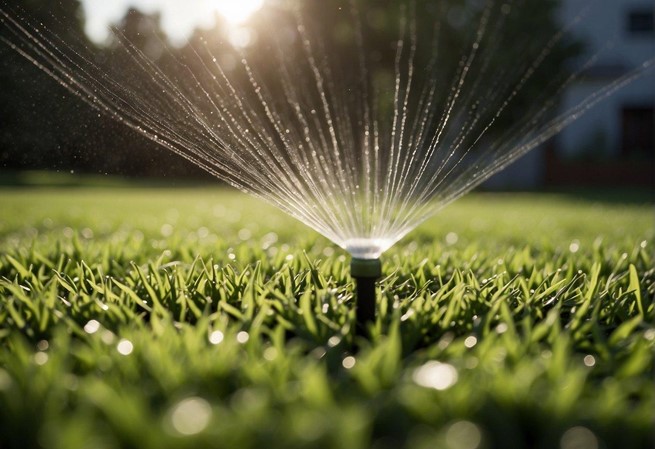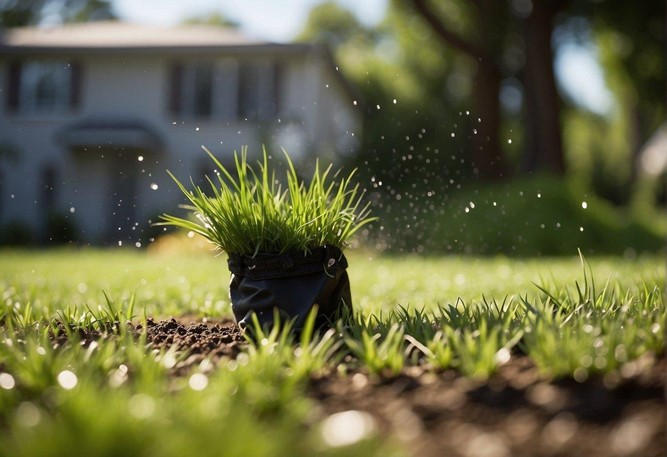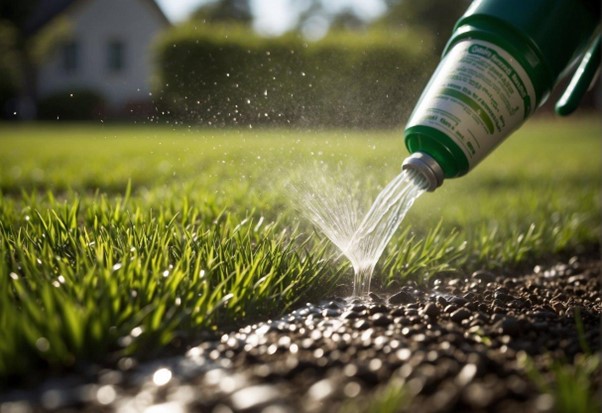
The Importance of Regular Fertilization in Conjunction with Your Lawn Irrigation
: 5 Minutes to Read
Maintaining a healthy and aesthetically pleasing lawn goes beyond the simple act of watering.
Regular fertilization in conjunction with proper irrigation practices plays a crucial role in fostering robust lawn growth and vitality.
Fertilization supplies essential nutrients that support the grass’s root systems, enhance its stress tolerance, and contribute to the overall density and color of the turf. Effective fertilization, therefore, is a cornerstone of comprehensive lawn care that works hand in hand with irrigation to create a lush and resilient lawn.
Understanding the symbiotic relationship between irrigation and fertilization is fundamental in achieving a well-nourished lawn. Irrigation ensures that water is delivered to the soil, aiding in the dissolution and distribution of the nutrients from fertilizers.
Conversely, without adequate watering, even the most carefully selected fertilizers cannot fully benefit the grass. The key lies in balancing these two elements to support soil health, fulfill nutrient needs, and prevent issues such as nutrient runoff or water waste.
A thorough grasp of these practices ensures that the lawn receives all it requires for vigorous growth while also being considerate of the environment.
Key Takeaways
- Regular fertilization alongside proper irrigation is essential for a healthy lawn.
- A balanced application ensures efficient nutrient uptake and soil vitality.
- Synergizing watering and fertilization practices promotes environmental responsibility.
Understanding Soil and Grass Needs

To ensure a healthy and vibrant lawn, homeowners must recognize the critical interplay between soil conditions and the specific needs of their grass variety. Regular soil assessments and an understanding of grass-specific nutrient requirements are fundamental to optimal lawn care.
Soil tests are invaluable for assessing the health of your lawn’s soil, revealing essential nutrients or nutrient deficiencies. These tests can determine pH levels, which affect nutrient availability, and they can identify the proportions of nitrogen (N), phosphorus (P), and potassium (K)—collectively known as the NPK value essential for lawn growth.
It’s recommended to perform a soil test at least once every one to three years.
- Essential Measurements in Soil Testing:
- NPK levels
- Soil pH
- Soil type
- Organic matter content
Grass species are commonly categorized into cool-season and warm-season grasses, each with distinct growth patterns and nutritional needs.
Cool-season grasses thrive in northern climates with significant temperature shifts, while warm-season grasses are suited to southern regions where temperatures remain warmer year-round. Identifying your grass type is crucial when selecting the proper fertilization schedule and formulation.
- Examples of grass types:
- Cool-season: Kentucky bluegrass, tall fescue, ryegrass
- Warm-season: Bermuda grass, zoysia, St. Augustine grass
Nutrient Requirements and Fertilizers
Nutrient-rich soil promotes healthy lawn growth, necessitating the use of fertilizers tailored to your lawn’s specific needs. Organic fertilizers improve soil structure over time, while granular fertilizers can offer a more controlled release of nutrients.
Fertilizer labels provide the NPK ratio, guiding you to the correct formulation. Balancing these nutrients is critical, as too much or too little can be detrimental to lawn health.
- Key Nutrients for Healthy Lawn Growth:
- Nitrogen: promotes leaf development and vibrant green color.
- Phosphorus: supports root growth and plant maturity.
- Potassium: enhances resistance to drought, disease, and cold.
Optimizing Fertilization Practices

Optimizing fertilization practices for a lawn requires understanding the right timing, appropriate techniques, and the balance between nourishing the soil and watering. Incorporating organic matter enhances the effectiveness of these practices.
Choosing the Right Fertilization Schedule
Selecting an accurate fertilization schedule is crucial for lawn health. Typically, spring and fall are the pivotal times for lawn fertilization to promote robust growth and prepare the grass for dormant periods, respectively. It is essential to adopt a regular fertilization frequency that suits the specific type of grass and local climate conditions.
Transform Your Lawn with Professional Fertilization and Care!
Is your lawn looking dull and lifeless? Our expert fertilization and lawn care services at New Jersey Best Lawns, Sprinklers & Fencing will revitalize your yard. Enjoy a greener, healthier lawn all year round. Get started with a free lawn assessment today and see the difference!
Effective Application Techniques
The technique used for applying fertilizers significantly impacts their efficiency. Utilizing slow-release fertilizers can provide a steady supply of nutrients over time, reducing the risk of over-fertilizing. Furthermore, calibrating application rates precisely according to package instructions ensures that the lawn receives the exact amount of nutrients required.
Balancing Fertilization and Irrigation
A steady balance between fertilization and irrigation is pivotal for optimal water retention and nutrient absorption. Over-watering can lead to nutrient runoff, whereas under-watering can hinder the effectiveness of the fertilizers.
The right watering schedule complements fertilization and contributes to a healthier lawn.
Incorporating organic matter, such as compost, into the lawn’s soil structure can improve nutrient content and enhance soil texture for better water retention. This practice supports the lawn’s ecosystem and reduces the need for chemical fertilizers while promoting a more resilient turf.
Secure and Beautify Your Property with Quality Fencing!
Looking to enhance your property’s privacy and aesthetics? New Jersey Best Lawns, Sprinklers & Fencing provides durable and stylish fencing solutions tailored to your needs. Protect your home and add curb appeal. Contact us for a free quote and build the perfect fence today!
Maximizing Lawn Health and Appearance
A well-maintained lawn not only enhances the visual appeal of a property but also contributes to its overall curb appeal. Achieving a lush and healthy lawn requires a strategic combination of fertilization, proper mowing techniques, and pest management.
The following subsections detail precise methods to ensure your lawn remains in peak condition.
Aeration is the process of creating small holes in the lawn to allow air, water, and nutrients to penetrate the grass roots.
This helps the roots grow deeply and produce a stronger, more vigorous lawn. The best time for aeration is during the growing season when the lawn can heal and fill in any open areas after soil plugs are removed.
Overseeding following aeration can enhance the lawn’s density, reducing weed outbreaks and increasing its resistance to pests and diseases.
An integral component of lawn care is Integrated Pest Management (IPM), which combines biological, cultural, and chemical tools in a way that minimizes economic, health, and environmental risks.
By employing IPM, lawn care professionals can effectively monitor for pests and diseases, ensuring that action is taken at the right time to control them. Utilizing pest control and weed control measures as part of routine lawn care maintains both the health and appearance of the lawn.
Mowing and Watering Strategies
Adopting proper mowing practices is critical for a healthy lawn. This includes mowing at the appropriate height, which depends on the grass type, and keeping mower blades sharp to ensure clean cuts.
Grass should typically be trimmed to a height of 3 inches to protect the root system and prevent weeds. When it comes to watering, the lawn should receive an inch of water per week, either from rainfall or irrigation.
Consistent, deep watering encourages deep root growth and a more well-maintained lawn.
Environmental and Safety Considerations
When incorporating fertilization into lawn care, it’s crucial to consider its potential effects on the environment and adhere to safety precautions.
These practices not only safeguard the local ecosystem but also promote environmental sustainability.
Struggling to maintain your property’s
Struggling to maintain your property’s appearance and functionality? New Jersey Best Lawns, Sprinklers & Fencing provides comprehensive property management services to keep your landscape looking its best. Enjoy a well-maintained property without the hassle. Get a free consultation today!
Understanding Environmental Impact
Fertilization, if not managed properly, can lead to soil erosion and disruption of the local ecosystem. Excessive nutrients from fertilizers can wash away into water bodies, causing eutrophication, which severely degrades water quality and aquatic life.
To understand the environmental impact of lawn fertilization, continuous evaluation of its interaction with the local climate and environmental considerations—such as native plant life and water tables—is essential.
- Soil Testing: Regular soil testing can prevent over-fertilization, reducing the risk of soil erosion and water system contamination.
- Selection of Fertilizers: Opting for organic or slow-release fertilizers minimizes the risk of nutrient runoff into nearby ecosystems.
Using Safe Fertilization Practices
Safety precautions are paramount when working with fertilizers, herbicides, and insecticides to ensure environmental sustainability.
Proper application techniques must be employed to avoid direct harm to non-target plants and animals as well as to reduce the risk of hazardous exposure to humans.
- Personal Protective Equipment (PPE): Utilizing gloves, masks, and other protective gear when applying products can prevent direct contact with potentially harmful substances.
- Application Guidelines: Following manufacturer guidelines for application rates and conditions minimizes potential hazards, protecting both the applicator and the environment.
Summary
- Regular fertilization and proper irrigation are crucial for a healthy lawn.
- Fertilization provides essential nutrients, supporting root systems, and stress tolerance.
- Balancing fertilization and irrigation ensures efficient nutrient uptake and soil health.
- Soil tests determine pH levels and NPK values (nitrogen, phosphorus, potassium).
- Cool-season grasses (e.g., Kentucky bluegrass) and warm-season grasses (e.g., Bermuda grass) have different needs.
- Organic fertilizers improve soil structure; granular fertilizers offer controlled nutrient release.
- Spring and fall are key times for fertilization.
- Slow-release fertilizers reduce over-fertilizing risks.
- Proper irrigation complements fertilization, preventing nutrient runoff.
- Compost improves nutrient content and soil texture.
- Aeration allows nutrients to reach roots; overseeding enhances density.
- Integrated Pest Management (IPM) minimizes risks and ensures lawn health.
- Maintain grass height at 3 inches to protect roots and prevent weeds.
- Lawns need about an inch of water per week.
- Prevent nutrient runoff and soil erosion with proper practices.
- Use personal protective equipment (PPE) and follow application guidelines for safety.
- Fertilization enhances lawn health by providing essential nutrients.
- Synchronizing fertilization with irrigation ensures effective nutrient delivery.
- Light watering after fertilization helps nutrients penetrate the soil.
- Over-irrigation can cause nutrient runoff and shallow root systems.
- Coordinate fertilization and irrigation based on grass type, climate, and soil conditions, with 2-4 applications per year.
Frequently Asked Questions
Regular fertilization, when paired with a proper irrigation schedule, is key to achieving a vibrant and healthy lawn. Here are some specific questions and answers to help you understand this relationship better.
How does fertilization enhance lawn health and growth?
Fertilization provides essential nutrients to the lawn, such as nitrogen, which is necessary for the vigorous growth of grass and the development of a lush, green color. The grass receives these nutrients and uses them to grow stronger and more resilient to environmental stresses.
What are the benefits of synchronizing fertilization with irrigation schedules?
Synchronizing fertilization with irrigation ensures that the nutrients are effectively dissolved and delivered to the grassroots. Water helps move the fertilizer into the soil profile, preventing nutrient runoff and maximizing the efficiency of the fertilization process.
Which nutrients are most crucial for lawn maintenance, and how are they affected by watering practices?
Nitrogen, phosphorus, and potassium are the most crucial nutrients for lawn maintenance. Correct watering practices ensure that these nutrients penetrate deeply into the soil to reach the roots where they are needed. Too little water can prevent the nutrients from being absorbed, while too much can cause them to leach away.
What are the best practices for applying fertilizer in relation to irrigation techniques?
The best practice is to lightly water the lawn after applying granular fertilizers to help it break down and reach the soil. However, heavy watering immediately after fertilization should be avoided, as it can wash away the nutrients before they have a chance to be absorbed.
Can over-irrigation harm the effectiveness of fertilization on lawns?
Yes, over-irrigation can harm the effectiveness of fertilization by causing nutrient runoff or leaching, especially in the case of soluble fertilizers. It can also lead to a shallow root system, as the grass becomes used to the surface water and doesn’t grow deeper roots to seek out moisture and nutrients.
How often should fertilization and irrigation be coordinated for optimal lawn care?
Fertilization and irrigation should be coordinated based on the type of grass, local climate, and soil conditions. Generally, applying fertilizer 2-4 times a year is recommended, with adjustments made for the growing season, and irrigation should be adjusted to support the fertilizer schedule and the lawn’s needs.
